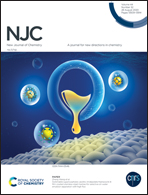Modulation of interparticle gap for enhanced SERS sensitivity in chemically stable Ag@Au hetero-architectures†
Abstract
Despite the excellent surface-enhanced Raman scattering (SERS) activity, the poor chemical stability of Ag nanoparticles severely hinders their application as SERS substrates. In this paper, a two-step process was used to prepare highly sensitive and chemically stable Ag@Au hetero-architectures, in situ growth of Ag nanoparticles on a Si wafer followed by Au coating through ion sputtering. Owing to the chemical inertness of Au, the Ag@Au hetero-architecture substrates exhibited enhanced chemical stability compared to pure Ag nanoparticle substrates. In particular, the deposition of Au coatings could efficiently modulate the gap between the neighboring Ag nanoparticles and strengthen the surface plasmon coupling effect. As a consequence, the Ag@Au hetero-architecture substrates exhibited a higher SERS sensitivity than pure Ag nanoparticle substrates. Furthermore, a possible mechanism for the enhanced SERS sensitivity of the Ag@Au hetero-architecture substrates was proposed and discussed. The present work came up with an effective and facile way to tune SERS sensitivity and chemical stability of Ag nanoparticle substrate, and in the meantime, implied a promising SERS application in oxidative environments or biological systems.



 Please wait while we load your content...
Please wait while we load your content...